Beliebte Kurse 'Astronomy' bei Astronomy
Astronomy Studienführer, Klassennotizen & Zusammenfassungen
Suchst du nach den besten Studienführern, Studiennotizen und Zusammenfassungen über Astronomy? Auf dieser Seite findest du 170 Studienunterlagen zu Astronomy.
All 170 Ergebnisse
Sortieren nach
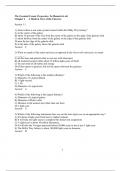 Beliebt
Beliebt
-
Test Bank for The Essential Cosmic Perspective, 9th Edition by Jeffrey O. Bennett
- Prüfung • 722 Seiten • 2023
-
- 46,87 €
- 7x verkauft
- + erfahre mehr
Test Bank for The Essential Cosmic Perspective, 9e 9th Edition by Jeffrey O. Bennett, Megan O. Donahue; Nicholas Schneider; Mark Voit. Full chapters test bank included A Modern View of the Universe Discovering the Universe for Yourself The Science of Astronomy PART II: KEY CONCEPTS FOR ASTRONOMY Making Sense of the Universe: Understanding Motion, Energy, and Gravity Light: The Cosmic Messenger PART III: LEARNING FROM OTHER WORLDS Formation of the Solar System Earth and the Terrestr...
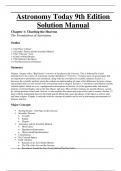
-
Complete Solution Manual Astronomy Today 9th Edition Questions & Answers with rationales
- Prüfung • 362 Seiten • 2023 Beliebt
-
- 16,09 €
- 2x verkauft
- + erfahre mehr
Astronomy Today 9th Edition Solution Manual Complete Solution Manual Astronomy Today 9th Edition Questions & Answers with rationales PDF File All Pages All Chapters Grade A+

-
Astronomy TOP Study Guide Questions and CORRECT Answers
- Prüfung • 40 Seiten • 2024
-
- 11,36 €
- + erfahre mehr
To get started, click on the blue Cepheids link on the main screen of the Interactive Figure. The Interactive Figure (in red) shows a graph of the Cepheid period-luminosity relation. This graph indicates that __________. - Cepheids with longer periods have higher luminosities A Cepheid with a period of 30 days has an average luminosity that is about __________ times the luminosity of the Sun. - 10,000 Click on the blue "Cepheid" label, then click the label on the bottom of the Intera...

-
Astronomy Key PASSED Questions and CORRECT Answers
- Prüfung • 4 Seiten • 2024
-
- 10,41 €
- + erfahre mehr
astronomy - The study of the moon, stars and other objects in space. asteroids - objects that are revolving around the sun that are to small and too numerous to be considered planets. black hole - The remains of an extremely massive star pulled into a small volume by the force of gravity. comet - a ball of ice and dust whose orbit is a long, narrow ellipse. galaxy - A giant structure that contains hundreds of billions of stars. gas giants - The name given to the first four outer planets...
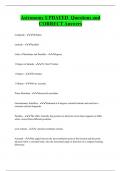
-
Astronomy UPDATED Questions and CORRECT Answers
- Prüfung • 17 Seiten • 2024
-
- 11,83 €
- + erfahre mehr
Longitude - Meridian Latitude - Parallels Units of Meridians and Parallels - Degrees 1 Degree of latitude - 112 km/70 miles 1 Degree - 60 minutes 1 Minute - 60 arc seconds Prime Meridian - Greenwich meridian Geostationary Satellites - Stationed at 0 degrees celestial latitude and each has a constant celestial longitude Parallax - The effect whereby the position or direction of an object appears to differ when viewed from different position
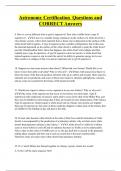
-
Astronomy Certification Questions and CORRECT Answers
- Prüfung • 10 Seiten • 2024
-
- 10,88 €
- + erfahre mehr
8. How is a nova different from a type Ia supernova? How does it differ from a type II supernova? - A nova is a smaller energy explosion on the surface of a white dwarf in a close binary system, where fresh material from a donor star is deposited on the surface of the white dwarf until it ignites. A type Ia supernova has a similar configuration, but in this case, the material deposited on the surface of the white dwarf is sufficient to push the white dwarf past the Chandresekhar limit....

-
Astronomy TOP Study Guide Questions and CORRECT Answers
- Prüfung • 40 Seiten • 2024
-
- 9,46 €
- + erfahre mehr
To get started, click on the blue Cepheids link on the main screen of the Interactive Figure. The Interactive Figure (in red) shows a graph of the Cepheid period-luminosity relation. This graph indicates that __________. - Cepheids with longer periods have higher luminosities A Cepheid with a period of 30 days has an average luminosity that is about __________ times the luminosity of the Sun. - 10,000 Click on the blue "Cepheid" label, then click the label on the bottom of the Intera...
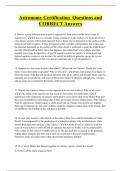
-
Astronomy Certification Questions and CORRECT Answers
- Prüfung • 10 Seiten • 2024
-
- 8,51 €
- + erfahre mehr
8. How is a nova different from a type Ia supernova? How does it differ from a type II supernova? - A nova is a smaller energy explosion on the surface of a white dwarf in a close binary system, where fresh material from a donor star is deposited on the surface of the white dwarf until it ignites. A type Ia supernova has a similar configuration, but in this case, the material deposited on the surface of the white dwarf is sufficient to push the white dwarf past the Chandresekhar limit....

-
Astronomy Key PASSED Questions and CORRECT Answers
- Prüfung • 4 Seiten • 2024
-
- 7,57 €
- + erfahre mehr
astronomy - The study of the moon, stars and other objects in space. asteroids - objects that are revolving around the sun that are to small and too numerous to be considered planets. black hole - The remains of an extremely massive star pulled into a small volume by the force of gravity. comet - a ball of ice and dust whose orbit is a long, narrow ellipse. galaxy - A giant structure that contains hundreds of billions of stars. gas giants - The name given to the first four outer planets...
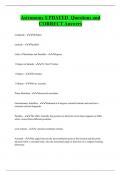
-
Astronomy UPDATED Questions and CORRECT Answers
- Prüfung • 17 Seiten • 2024
-
- 8,51 €
- + erfahre mehr
Longitude - Meridian Latitude - Parallels Units of Meridians and Parallels - Degrees 1 Degree of latitude - 112 km/70 miles 1 Degree - 60 minutes 1 Minute - 60 arc seconds Prime Meridian - Greenwich meridian Geostationary Satellites - Stationed at 0 degrees celestial latitude and each has a constant celestial longitude Parallax - The effect whereby the position or direction of an object appears to differ when viewed from different position

-
Astronomy Bundled Exams with Complete Solutions...Grade A+
- Paket-deal • 10 Sachen • 2024
-
- 29,35 €
- + erfahre mehr
Astronomy - Final Exam With Complete Solutions 100% Solved 2 Exam (elaborations) Astronomy Final Exam with Complete Solutions and Answers 100% Solved 3 Exam (elaborations) Astronomy Final Exam with Complete Solutions 100% Solved 4 Exam (elaborations) Astronomy Final Exam with Complete Solutions 100% Verified 5 Exam (elaborations) Astronomy Fina

-
Astronomy - Final Exam With Complete Solutions 100% Solved
- Prüfung • 12 Seiten • 2024
-
Im Paket-Deal erhältlich
-
- 13,25 €
- + erfahre mehr
Astronomy - Final Exam With Complete Solutions 100% Solved How are galaxies created? ️️One says that galaxies were born when vast clouds of gas and dust collapsed under their own gravitational pull, allowing stars to form. ... The other, which has gained strength in recent years, says the young universe contained many small "lumps" of matter, which clumped together to form galaxies. How was Hubble important to our understanding of galaxies? ️️he discovered the existence of ...



